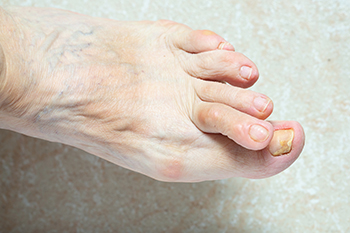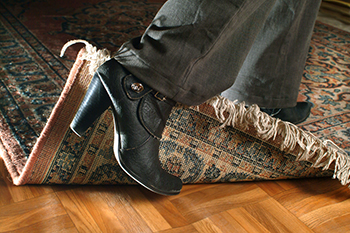Items filtered by date: November 2023
Hammertoe Is a Deformity That May Affect Foot Health

Hammertoe, a prevalent foot deformity, poses significant challenges for those affected. This condition occurs when the toe joints bend unnaturally, resembling a hammer's shape. Typically afflicting the second toe, it can result from various factors such as wearing ill-fitting footwear, muscle imbalances, or genetic predispositions. The deformity leads to discomfort, pain, and difficulty in finding suitable shoes. Left untreated, hammertoe may progress, causing rigidity and requiring medical intervention. Individuals with hammertoe often face limitations in daily activities and may experience corns or calluses due to friction and pressure. It is vital to address symptoms promptly, seeking professional advice to explore non-invasive treatments or corrective measures. Understanding the causes and symptoms of hammertoe empowers individuals to make informed decisions about their foot health, emphasizing preventive measures and early interventions to alleviate discomfort and maintain an active lifestyle. If you have this type of deformity, it is strongly suggested that you consult a chiropodist who can guide you toward relief and treatment options.
Hammertoe is a common foot deformity in which one or more of the small toes bends downwards at the middle joint. Though it may seem like a purely cosmetic issue, this is not the case. Hammertoes can be uncomfortable, painful, and even debilitating in severe cases. If you suffer from hammertoe, please consult with one of the chiropodists from Complete Family Footcare & Therapy. Our clinicians can help you maintain the health of your lower limbs and your mobility.
Symptoms
One or more small toes bending downward at the middle joint
Pain or irritation on the affected toes
Corns and calluses
Inflammation
Redness
Stiff toe joints
Sores on the tops of the toes
Diagnosis
A chiropodist can typically diagnose hammertoes through physical examination. X-rays may need to be taken to see the extent of the damage.
Treatment
Hammertoes tend to progressively worsen with time, so getting prompt treatment is very important. In its early stages, the progression of hammertoe can be slowed down or stopped. Your chiropodist may suggest changes in your footwear. Wearing wide, comfortable shoes with a larger toe area and a low heel can help you avoid putting pressure on your toes. You may also be prescribed orthotics. Over-the-counter medications or corticosteroid injections may be used to relieve pain. If you have any corns or calluses, your chiropodist may suggest padding them to avoid further irritation. In advanced cases, surgery may be suggested.
If you have any questions, please feel free to contact our offices located in . We offer the newest diagnostic and treatment technologies for all your foot care needs.
Intricate Anatomy of the Human Foot

The human foot is an engineering marvel, a symphony of bones, ligaments, muscles, and tendons choreographed to facilitate movement and provide stability. At its core are 26 bones, including the talus, calcaneus, metatarsals, and phalanges, meticulously connected by a network of joints. The arches, formed by the complex arrangement of bones and ligaments, impart elasticity and absorb shock during weight-bearing activities. Muscles, both intrinsic and extrinsic, function harmoniously to control movement, balance, and precision. The Achilles tendon, a robust band of connective tissue, links the calf muscles to the heel bone, allowing for propulsion and extension of the foot. Ligaments and fascia interlace, providing support and maintaining the foot's structural integrity. Understanding the foot's anatomy is essential for appreciating its remarkable capabilities and addressing various foot-related issues that affect our daily lives. If you are interested in learning more about the biomechanics of the feet, it is suggested that you consult a chiropodist who can provide you with the information you are seeking.
The biomechanics of your feet play an important role in your foot health. To learn more, please consult with one of the chiropodists from Complete Family Footcare & Therapy. Our clinicians can help you maintain the health of your lower limbs and your mobility.
Foot biomechanics refers to the study of the structure, function, and motion of the feet. The feet and ankles are a complex system consisting of many bones, joints, ligaments, muscles, and tendons that work together to move your feet. Understanding the unique biomechanics of your own feet can help you and your chiropodist make informed decisions about your foot health care. This includes decisions about the best preventive measures to avoid foot pain, the best treatment options for various foot problems, and finding the best shoes for your feet.
If you have any questions, please feel free to contact our offices located in . We offer the newest diagnostic and treatment technologies for all your foot care needs.
Fascinating Facts About Children's Feet

Children's feet are incredible and unique in their own right, with a few distinct characteristics worth exploring. Unlike adults, children's feet are not fully formed and are composed of softer cartilage, which gradually hardens into bone as they grow. During the early years, their arches are not fully developed, which is why many children have flat feet. Their arches typically develop by the age of six. Children's feet also grow rapidly, with their shoe size changing approximately every few months in their early years. It is important for parents to ensure their children wear shoes that fit correctly, as ill fitting shoes can lead to foot problems. Additionally, kids often have more sweat glands in their feet than adults, making them prone to sweaty and sometimes smelly feet. Understanding these facts about children's feet can help parents better care for their little ones' foot health as they embark on their journey of growth and exploration. If you would like more information about children’s feet, it is suggested that you consult a chiropodist who can provide you with the knowledge you are seeking.
If your child is experiencing foot or ankle pain, please consult with one of the chiropodists from Complete Family Footcare & Therapy. Our clinicians will assess your condition and provide you with quality foot and ankle treatment.
Common Causes of Foot Pain in Children
While children can experience many of the same foot problems as adults do, some foot problems may be more common during childhood.
Causes of foot pain in children can include:
Deformities that are present from birth, such as flat feet or clubfoot
Sever’s disease, which is an inflammation of the growth plate in the heel bone
Various sports injuries, such as sprains and fractures
Ingrown toenails
Athlete’s foot
Plantar warts
Prevention
It is important to look after the health of children’s feet in order to prevent future problems from arising. Keep your child’s feet clean and dry, trim their toenails regularly, ensure their shoes fit properly, and keep a watchful eye on any symptoms of foot pain, such as limping. If you notice any symptoms or if your child complains of foot pain, a chiropodist can help.
If you have any questions, please feel free to contact our offices located in . We offer the newest diagnostic and treatment technologies for all your foot care needs.
Footwear and Fall Prevention

Falls can happen at any age, but as we get older, the risk of sustaining serious injuries from falls increases. While numerous factors contribute to falls, your choice of footwear plays a critical role in preventing these accidents. Wearing the right shoes can significantly reduce the risk of slipping and tripping, providing stability and support. Proper footwear should fit well, offering adequate support for your arches, heels, and ankles. Non-slip soles with good traction are vital, especially on slippery surfaces. Low, broad heels and a snug fit around the ankles enhance stability. It is beneficial to avoid shoes with high heels or worn-out soles, as they increase the likelihood of imbalance. Additionally, velcro or lace-up shoes can be more secure than slip-ons. Investing in quality, comfortable shoes is an investment in your safety. By prioritizing suitable footwear, you can reduce the risk of falls. If you would like the shoes you choose evaluated or additional information about what shoes can be worn that can help to minimize falling, it is suggested that you consult a chiropodist.
Falls are a major cause of injury among the elderly. To learn more about preventing falls or to get treatment following a foot or ankle injury caused by a fall, please consult with one of the chiropodists from Complete Family Footcare & Therapy. Our clinicians will assess your condition and provide you with quality foot and ankle treatment.
Falling is one of the leading causes of injury among the elderly. It is said that about 50% of falls that result in hospitalization occur in the home. Fortunately, there are steps that you can implement to reduce your risk of falling in the home.
Tips to Prevent Falls at Home:
In the bathroom - Place non-slip mats in the shower or tub, install grab bars near the toilet and bath, and wipe up any moisture or spills as soon as possible.
In the living rooms and bedroom - Remove loose wires, cords, or other objects that may be an obstacle to moving around safely. Make sure that you have good lighting throughout the home so that you can always see where you are going. Get rid of any rugs or mats that are not firmly anchored or that may cause you to trip. When walking around the home, move slowly.
In the kitchen - Store food and supplies in easily accessible areas, store heavy items in lower cupboards, and wipe up any spills immediately to prevent slipping.
On the stairs - Make sure that the stairs are well-lit and have secure handrails. Walk slowly when ascending or descending the stairs.
Outside - Keep walkways well-lit and clear of snow, ice, leaves, and man-made tripping hazards.
Maintaining your overall health, including the health of your feet, can also help to prevent falls. Eat a healthy diet, exercise regularly, and wear well-fitted, comfortable, and supportive shoes. If you have a mobility device, such as a cane, use it while walking.
If you have any questions, please feel free to contact our offices located in . We offer the newest diagnostic and treatment technologies for all your foot care needs.

